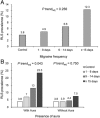Prevalence of restless legs syndrome in migraine patients with and without aura: a cross-sectional, case-controlled study
- PMID: 27770406
- PMCID: PMC5074935
- DOI: 10.1186/s10194-016-0691-0
Prevalence of restless legs syndrome in migraine patients with and without aura: a cross-sectional, case-controlled study
Abstract
Background: Although the comorbidity of migraine and restless legs syndrome (RLS) has been well-documented, the association between RLS and migraine frequency has yet to be elucidated. The present study aims to evaluate the prevalence of RLS among individuals who experience low-frequency, high-frequency, or chronic migraine presenting with and without aura.
Methods: We conducted a cross-sectional, case-controlled study involving 505 participants receiving outpatient headache treatment. Standardized questionnaires were administered to collect information on experiences of migraine, RLS, sleep quality, anxiety, depression, and demographics. Participants were categorized into low-frequency (1-8/month), high-frequency (9-14/month), and chronic (≥15/month) headache groups. RLS was diagnosed according to the criteria outlined by the International RLS Study Group (IRLSSG). The Pittsburgh Sleep Quality Index (PSQI) and Hospital Anxiety and Depression Scale (HADS) were used to assess sleep quality and identify symptoms of anxiety and depression. Associations between migraine frequency and RLS prevalence were investigated using multivariate linear and logistic regression.
Results: Univariate analysis revealed an effect of migraine frequency on RLS prevalence (p = 0.026), though this effect did not persist following adjustment for baseline characteristics (p = 0.256). The trend was robust in patients whose migraines presented with auras (p univariate = 0.002; p multivariate = 0.043) but not in those without auras (p univariate and p multivariate > 0.05). Higher anxiety [odds ratio (OR) = 1.18, p = 0.019] and sleep disturbance (OR = 1.17, p = 0.023) scores were associated with higher RLS prevalence.
Conclusions: Higher migraine frequency correlates with a higher prevalence of RLS, particularly among patients with auras.
Keywords: Dopamine; Hospital anxiety and depression subscales; Iron metabolism; Migraine; Pittsburgh sleep quality index; Restless legs syndrome.
Figures
References
MeSH terms
LinkOut - more resources
Full Text Sources
Other Literature Sources
Medical
Miscellaneous


